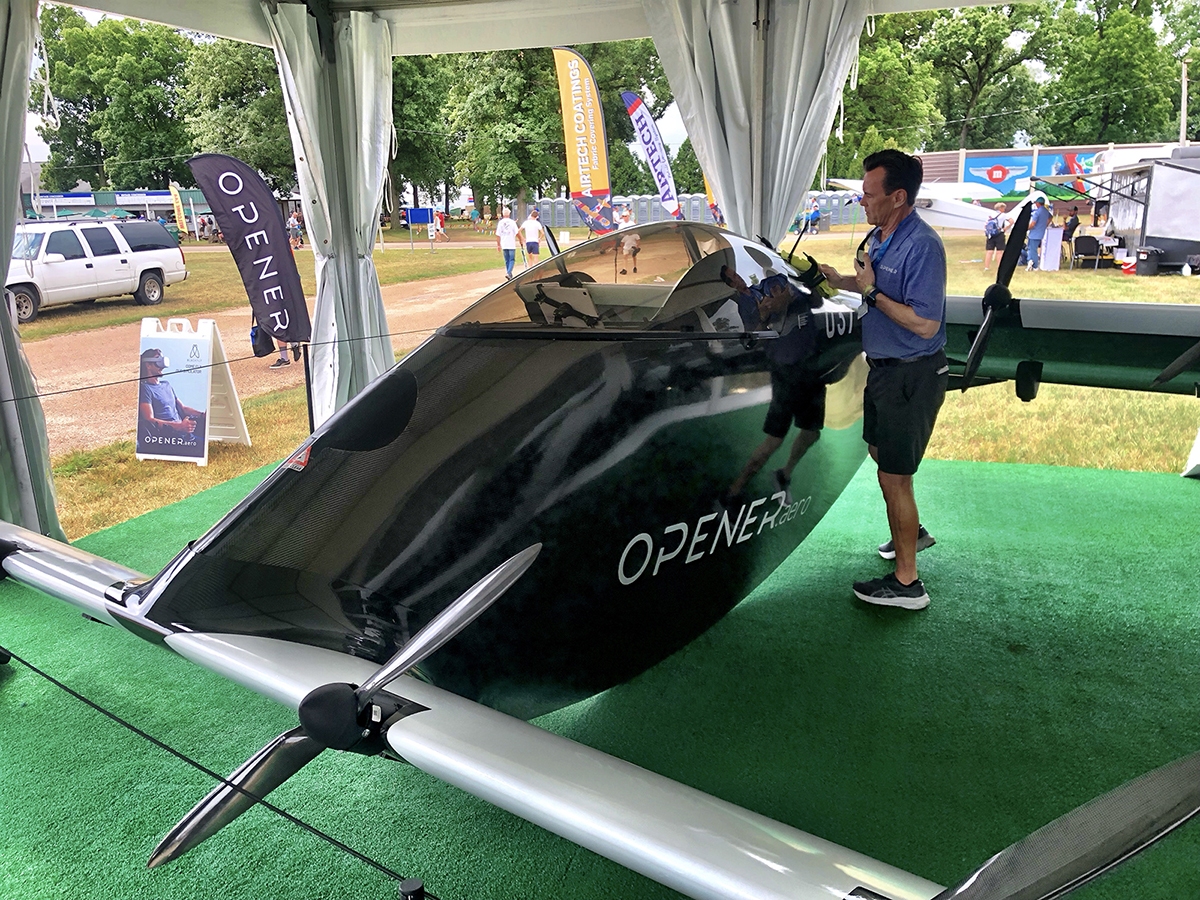Stay Up to Date
Submit your email address to receive the latest industry and Aerospace America news.
Sales of personal air vehicles have begun with no certification requirements
This story has been updated to correct the date of Opener LLC’s inaugural piloted cruise flight at EAA AirVenture.
The personal air vehicle revolution predicted four years ago by investment firm Morgan Stanley will have to start somewhere, and we might be seeing that start with the first orders reported by two companies, one based in Silicon Valley and one in Stockholm.
Opener LLC, founded in California in 2009, has created BlackFly, a one-person, all-electric aircraft that takes off and lands vertically with four rotors distributed across the front and aft wings. An onboard pilot flew one in cruise mode for the first time publicly at the 2021 AirVenture show in Oshkosh, Wisconsin. This year at AirVenture, the first customer to receive a BlackFly, Tim Lum of rural central Washington state, attended and spoke to me. Opener also announced an early access program for selected customers, with signed sales contracts and delivery of some aircraft, but has not said how many.
Opener also has not said how much a BlackFly costs or what initial customers paid, but the early access program includes training and an agreement that customers will provide feedback on handling of the aircraft and the customer experience.
Jetson Aero, founded in Sweden in 2017, has created Jetson One — also an all-electric one person aircraft, but one with eight rotors for vertical lift and an open cockpit. The company has released videos of its executives and staff flying the aircraft, and its website provides the opportunity to put in an order for one of the $98,000 aircraft. A little over 300 orders have been received and “build slots” are reserved for those customers, according to the website. I wasn’t able to reach Jetson to learn more, including whether any deliveries have been made.
These developments mark a slow start to the $1.5 trillion annual market that Morgan Stanley predicted for the new class of aircraft. The prediction assumes that consumers will replace their cars with PAVs and that autonomous versions will carry cargo and eventually supplant the electric air taxis now in development. Today, neither the BlackFly nor Jetson One are fully autonomous.
Helpful is the fact that, in the eyes of FAA, personal air vehicles (or PAVs) are ultralight aircraft – a category that’s existed for decades in the form of gas-powered lightweight aircraft. A type certificate is not required to sell them, and operators do not need a pilot’s license. Ultralight aircraft, today, however, can only fly in uncontrolled airspace unless permission is obtained from air traffic controllers.
Opener, for one, predicts a vast potential for its aircraft.
“Building thousands per year may seem very rosy at this point, but we believe that is absolutely within the realm of possibility,” says Ken Karklin, the company’s CEO, adding that the company currently has plant capacity in Palo Alto to build about 200 aircraft per year. Plans call for moving to a larger facility soon, but the company isn’t ready to identify the location or timing.
“Our potential adopter [customer] is somewhere between 25 and 85, about 80% male, has a net worth north of a couple million bucks and some walking-around money and probably, you know, they have purchased a toy or two at some point in their life,” Karklin says. He says the aircraft, though not fully autonomous, is very easy to fly.
Karklin, like Morgan Stanley, believes that widespread use of PAVs will only happen when these aircraft and the U.S. air traffic control network are fully automated. He sees drone-based package delivery, which companies like Amazon and Walmart are attempting to develop, as leading the way for such automation. Right now, he says, the air traffic control system could not accommodate many thousands of single-person aircraft.
“A completely automated air traffic control system, that’s kind of the holy grail of AAM right there,” Karklin says, “and I believe it will be required for autonomous cargo delivery at scale, if we are ever to see that.”
One industry watcher who’s bullish about the potential of PAVs is Dennis Bushnell, retired chief scientist of NASA’s Langley Research Center in Virginia. He expects them to be the future of transportation in the U.S., where personal vehicles on the road have long dominated how people get around.
Bushnell says the cost of PAVs should come down dramatically as they begin to be mass produced.
“Eventually, these will cost somewhere on the order of a good quality automobile,” he predicts. “I think we could do tens of millions of vehicles popping up from everyone’s driveways in about five to 10 years, but only if FAA is able to adopt a completely automated air traffic management system without humans in charge. You can’t do it by modifying the current system.”
Due to airspace restrictions near airports and heavily populated areas, rural areas will see the first growth of PAVs, Bushnell says.
“Eventually, people will realize that we don’t need to build roads to some houses anymore,” he says.
Get the latest news about advanced air mobility delivered to your inbox every two weeks.
About paul brinkmann
Paul covers advanced air mobility, space launches and more for our website and the quarterly magazine. Paul joined us in 2022 and is based near Kennedy Space Center in Florida. He previously covered aerospace for United Press International and the Orlando Sentinel.
Related Posts
Stay Up to Date
Submit your email address to receive the latest industry and Aerospace America news.




